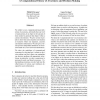103 search results - page 9 / 21 » On Using Matching Theory to Understand P2P Network Design |
SIGCOMM
2004
ACM
14 years 1 months ago
2004
ACM
A detailed understanding of the many facets of the Internet’s topological structure is critical for evaluating the performance of networking protocols, for assessing the effecti...
TARK
2009
Springer
14 years 2 months ago
2009
Springer
We exhibit a new computational-based definition of awareness, informally that our level of unawareness of an object is the amount of time needed to generate that object within a ...
GECCO
2005
Springer
14 years 1 months ago
2005
Springer
Mapping biology into computation has both a domain specific aspect – biological theory – and a methodological aspect – model development. Computational modelers have implici...
EDBTW
2010
Springer
14 years 2 months ago
2010
Springer
Graph composition has applications in a variety of practical applications. In drug development, for instance, in order to understand possible drug interactions, one has to merge k...
SCIE
1997
Springer
14 years 1 days ago
1997
Springer
Abstract. The task of information extraction can be seen as a problem of semantic matching between a user-defined template and a piece of information written in natural language. T...

